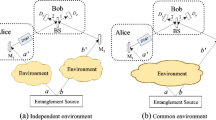Abstract
Physicists are attracted to open-system dynamics, how quantum systems evolve, and how they can be protected from unnecessary environmental noise, especially when environmental memory effects are non-negligible, as with non-Markovian approximations. There are several methods to solve the master equation of non-Markovian cases and we obtain the solutions of the quantum-state-diffusion equation for a two-qubit system using the perturbation method under the influence of various types of environmental noise, including relaxation noise, dephasing noise and their mixture. It was found that by inducing dephasing noise into the relaxation process strengthens the correlation between qubits by restoring the entanglement lost in the environment, thereby making it possible to optimize quantum teleportation fidelity and dense coding capacity via mixed noise under non-Markovian approximation.



Similar content being viewed by others
References
Ekert, A.K.: . Phys. Rev. Lett. 67, 661 (1991)
Bennett, C.H., Brassard, G., Crépeau, C., Jozsa, R., Peres, A., Wootters, W.K.: . Phys. Rev. Lett. 70, 1895 (1993)
Bennett, C.H., Wiesner, S.J.: . Phys. Rev. Lett. 69, 2881 (1992)
Nielsen, M.A., Chuang, I.L.: Quantum Computation and Quantum Information. Cambridge University Press, Cambridge (2000)
Shor, P.W.: . Phys. Rev. A 52, R2493 (1995)
Steane, A.M.: . Phys. Rev. Lett. 77, 793 (1996b)
Lidar, D.A., Chuang, I.L., Whaley, K.B.: . Phys. Rev. Lett. 81, 2594 (1998)
Kwiat, P.G., et al.: . Science 290, 498 (2000)
Viola, L., Knill, E., Lloyd, S.: . Phys. Rev. Lett. 82, 2417 (1999)
Yi, X.X., Sun, C.P.: . Phys. Lett. A 262, 287 (1999)
Strunz, W.T., Yu, T.: . Phys. Rev. A 69, 052115 (2004)
Corn, B., Yu, T.: . Quantum Inf. Process. 8, 565 (2009)
Jing, J., Wu, L.-A.: . Sci. Rep. 3, 2746 (2013)
Jing, J., Li, R., You, J.Q., Yu, T.: . Phys. Rev. A 91, 022109 (2015)
Beige, A., Braun, D., Tregenna, B.: . Knight, Phys. Rev. Lett. 85, 1762 (2000)
Jing, J., Ting, Y., Lam, C.-H., You, J.Q., Wu, L.-A.: . Phys. Rev. A 97, 012104 (2018)
Diósi, L., Gisin, N., Strunz, W.T.: . Phys.Rev.A 58, 1699 (1998)
Yu, T., Diosi, L., Gisin, N., Strunz, W.T.: . Phys.Rev. A 60, 91 (1999)
Chen, Yusui, You, J.Q., Ting, Y u: . Phys. Rev. A 90, 052104 (2014)
Holevo, A.S.: . Probl. Inf. Transm. 9, 177 (1973)
Simayi, S., Abulizi, A., Yaermaimaiti, M., Jiang-Tao, C., Pan-Pan, Q.: . Chin. Phys. B 20(5), 050305 (2011)
Boschi, D., Branca, S., De Martini, F., Hardy, L., Popescu, S.: . Phys. Rev. Lett. 80, 1121–1125 (1998)
Marcikic, I., de Riedmatten, H., Tittel, W., Zbinden, H., Gisin, N.: . Nature 421, 509–513 (2003)
Xiao-Song, M., et al.: . Nature 489, 269–273 (2012)
Bouwmeester, D., Pan, J.-W., et al.: . Nature 390, 575–579 (1997)
Jozsa, R.: . J. Mod. Opt. 41, 2315 (1994)
Lombardi, E., Sciarrino, F., Popescu, S., et al.: . Phys. Rev. Lett. 88, 070402 (2002)
Bowen, G., Bose, S.: . Phys. Rev. Lett. 87, 267901 (2001)
Zhang, G.-F.: . Phys. Rev. A 75, 034304 (2007)
Yu, T., Eberly, J.H.: . Phys. Rev. Lett. 93, 140404 (2004)
Luo, S.L., Fu, S.S.: . Phys. Rev. A 82, 034302 (2010)
Zhao, X., Jing, J., Corn, B., Yu, T.: . Phys. Rev. A 84, 032101 (2011)
Özdemir, S.K., Bartkiewicz, K., Liu, Y.-X., Miranowicz, A.: . Phys. Rev. A 76, 042325 (2007)
Misra, B., Sudarshan, E.C.G.: . J. Math. Phys. 18(4), 756–763 (1997)
Acknowledgments
This work is supported by Key Research and Development Plan of Ministry of Science and Technology, China (No. 2018YFB1601402) and also supported by the National Natural Science Foundation of China (Grant No.11864042).
Author information
Authors and Affiliations
Corresponding author
Additional information
Publisher’s Note
Springer Nature remains neutral with regard to jurisdictional claims in published maps and institutional affiliations.
Appendix: : The Explicit Expressions of \(O\left (t,s,z^{*}\right )\)
Appendix: : The Explicit Expressions of \(O\left (t,s,z^{*}\right )\)
By using the consistency condition \(\frac {\delta }{\delta z_{s}^{*}}\frac {\partial \psi _{t}\left (z_{t}^{*}\right )}{\partial t}=\frac {\partial }{\partial t}\frac {\delta \psi _{t}\left (z^{*}\right )}{\delta z_{s}^{*}}\), \(O\left (t,s,z^{*}\right )\) can be expanded as:
Where values of \(f_{1\sim 5}\) are time-dependent, and are noise free. Substituting the O operator with its expanded form in (10), we can obtain the partial differential equations that determine the coefficients of the O operator:
where \(F_{j}\left (t\right )={{\int \limits }_{0}^{t}}dsG\left (t,s\right )f_{j}\left (t,s\right )\) \(\left (j=1,2,3,4\right )\), and \(F_{5}\left (t,s_{1}\right )={{\int \limits }_{0}^{t}}dsG\left (t-s\right )f_{5}\left (t,s,s_{1}\right )\), with the initial conditions for equation above:
After obtaining the coefficients \(f_{1\sim 5}\) and \(F_{1\sim 5}\), as determined by (23), then \(O\left (t,s,z^{*}\right )\) can be obtained.
Rights and permissions
About this article
Cite this article
Islam, A., Wang, A.M. & Abliz, A. Optimizing Quantum Teleportation and Dense Coding via Mixed Noise Under Non-Markovian Approximation. Int J Theor Phys 60, 1225–1236 (2021). https://doi.org/10.1007/s10773-021-04748-6
Received:
Accepted:
Published:
Issue Date:
DOI: https://doi.org/10.1007/s10773-021-04748-6




